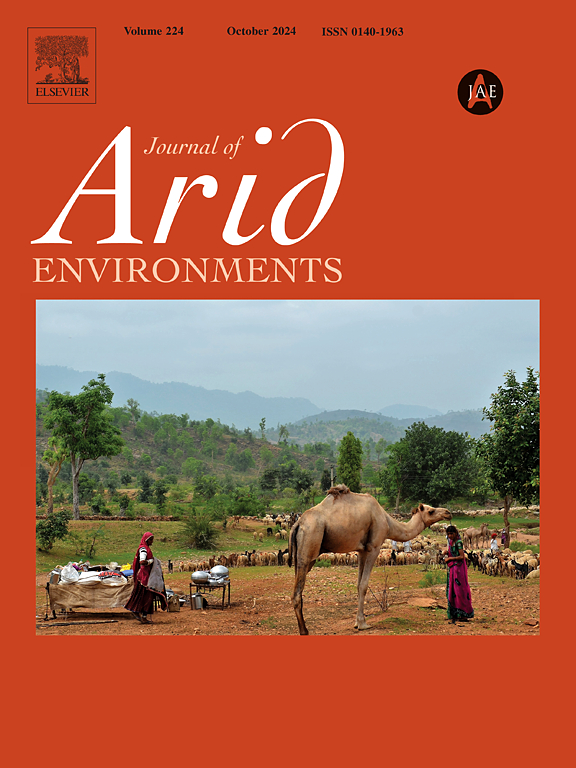Navigating climate shifts for an endemic lizard from a semi-arid environment
IF 2.5
3区 环境科学与生态学
Q2 ECOLOGY
引用次数: 0
Abstract
Ecological niche models (ENMs) are crucial for understanding species distribution and identifying areas maintaining climatic stability over time (i.e., thermal refugia). Human-induced global climate change underscores the importance of such refugia, which directly impacts species distribution, especially for ectothermic species relying on the environmental temperature to keep their metabolism active. Tropidurus cocorobensis is an endemic, heliothermic, and generalist lizard from Caatinga, a heterogeneous semi-arid domain characterized by low and irregular precipitation patterns and high temperature and solar radiation. Despite its endemism, there is no information concerning temporarily stable (refugial) and unstable (recently colonized) regions for its occurrence, nor future predictions of local thermal suitability in different climate change scenarios. Using ENMs, we assessed Caatinga's past, present, and future thermal suitability for T. cocorobensis, identifying potential changes in its thermal refugia over time. Our results indicated Depressão Sertaneja Meridional (DSM) and Campo Maior Complex (CMC) as climatically stable Caatinga Ecoregions, serving as climate refugia for T. cocorobensis. While DSM covers much of the species' current distribution, CMC lacks occurrence data. Contrastingly, the Chapada Diamantina Complex, a known habitat for the species, was not recovered as a climate refugia nor was suitable for future scenarios, therefore representing a climatically unstable area. Future projections indicate a potential expansion of T. cocorobensis' climate refugia, possibly linked to the species' generalist habits. However, the optimistic outlook for this species may not mirror the overall well-being of the Caatinga domain since generalist species often fill niches left by specialists unable to adapt to stressful environments. Future studies should prioritize comparing the climatic refugia of specialist and generalist species envisioning a comprehensive understanding of the ecological dynamics within the Caatinga ecosystem. This approach will be crucial for formulating effective conservation strategies amid the ongoing challenges of climate change in this domain.
为一种半干旱环境中特有的蜥蜴驾驭气候变化
生态位模型(ENM)对于了解物种分布和确定长期保持气候稳定的区域(即热庇护所)至关重要。人类引起的全球气候变化凸显了这种避难所的重要性,它直接影响到物种的分布,特别是对于依赖环境温度来保持新陈代谢活跃的外温物种。Tropidurus cocorobensis是卡廷加地区特有的一种日热型通食蜥蜴,卡廷加地区是一个多元半干旱地区,降水量少且不规则,温度和太阳辐射较高。尽管它是当地特有物种,但目前还没有关于它出现的暂时稳定(避难区)和不稳定(新近殖民)地区的信息,也没有关于不同气候变化情景下当地热适宜性的未来预测。利用 ENMs,我们评估了卡廷加过去、现在和未来对 T. cocorobensis 的热适宜性,确定了其热庇护所随着时间的推移可能发生的变化。结果表明,Depressão Sertaneja Meridional(DSM)和Campo Maior Complex(CMC)是气候稳定的卡廷加生态区,是T. cocorobensis的气候避难所。DSM 涵盖了该物种目前分布的大部分地区,而 CMC 则缺乏出现数据。相反,作为该物种已知栖息地的 Chapada Diamantina Complex 既没有被复原为气候避难所,也不适合未来情景,因此代表了一个气候不稳定的地区。未来预测表明,T. cocorobensis的气候避难所可能会扩大,这可能与该物种的通食习性有关。然而,该物种的乐观前景可能并不反映卡廷加区的整体福祉,因为通性物种往往填补了无法适应压力环境的专性物种留下的壁龛。未来的研究应优先比较专性物种和通性物种的气候避难所,以便全面了解卡廷加生态系统的生态动态。这种方法对于在该领域气候变化的持续挑战下制定有效的保护战略至关重要。
本文章由计算机程序翻译,如有差异,请以英文原文为准。
求助全文
约1分钟内获得全文
求助全文
来源期刊

Journal of Arid Environments
环境科学-环境科学
CiteScore
5.70
自引率
3.70%
发文量
144
审稿时长
55 days
期刊介绍:
The Journal of Arid Environments is an international journal publishing original scientific and technical research articles on physical, biological and cultural aspects of arid, semi-arid, and desert environments. As a forum of multi-disciplinary and interdisciplinary dialogue it addresses research on all aspects of arid environments and their past, present and future use.
 求助内容:
求助内容: 应助结果提醒方式:
应助结果提醒方式:


